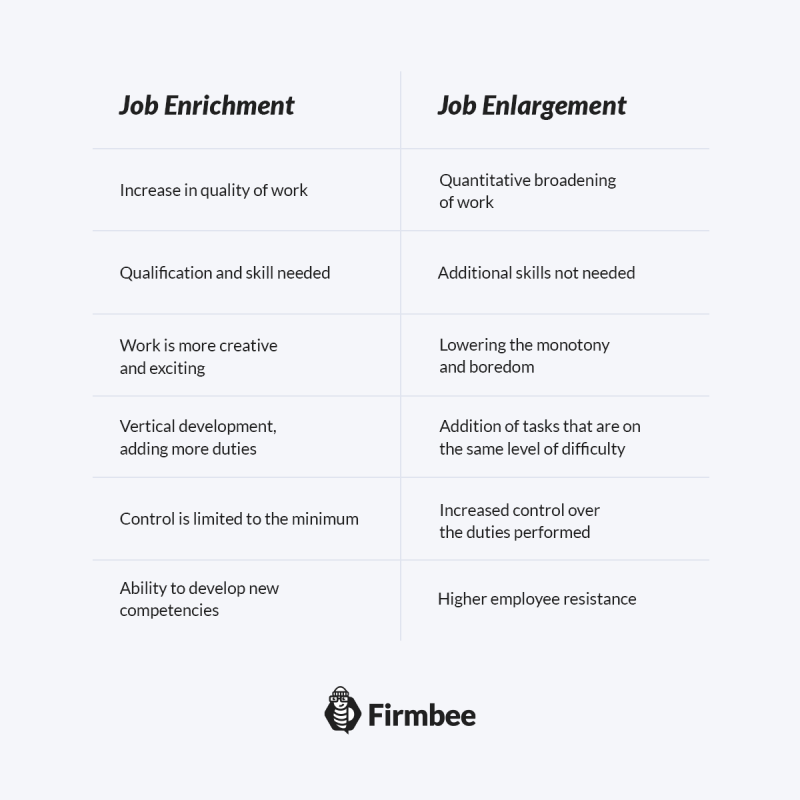Design of workplaces aims to improve work organization and develop competencies of employees. Two main approaches in the design of workplaces are specialization and alternative methods. The most popular alternative methods are job enrichment and job enlargement. The effective and efficient design of workplaces must be compatible with the organizational structure of the company and its specificity, management methods, and defined objectives. The selection of the method is based on the assumption that effective work and related satisfaction come from the internal content of the role. One needs to remember that people are motivated only when all the tools needed to reach the goals are provided.
Differences between job enlargement and job enrichment – table of contents:
- What is job enrichment?
- Job enrichment – the basic conditions and strategies
- Job enlargement
- Differences between job enlargement and job enrichment
- Summary
What is job enrichment?
The enrichment of the content of the job (potential of the job) is related to the function of competence development and motivational function. The method aims to maximize the interest in the role and the results of work by such designing of the position that it becomes the complete component of the work (defined effect of work), includes a variety of tasks, responsibility for the decisions made, control, and provides an opportunity to obtain feedback about executed tasks.
It is essential to use such stimuli and incentives that may increase work satisfaction. Job enrichment is related to the quality of work and it gives the job unique, creative, or almost exciting features. The method aims to eliminate the excessive division of work (specializations) allowing adaptation of performed tasks to employees’ competencies.
Job enrichment – the basic conditions and strategies
Designing of enriched workplaces one should remember certain assumptions, that have to be considered in conjunction:
- The employee performs his tasks from the beginning to the end and takes the full responsibility for them.
- To allow a higher level of identification of the employee with the organization such activities should be included: planning, preparation, implementation, realization, and control.
- Feedback related to the mistakes and successes achieved is necessary.
- Organizational culture should be based on trust and cooperation. The style of management should be based on partnership, support, and co-responsibility.
- Freedom of choice concerning tools and methods needed for the realization of the given task should be ensured
The practice of human resource management suggests three basic strategies of job enrichment:
- Enrichment of single tasks – the employee takes full responsibility for the realization of the task, the time, and the method of performance.
- Job enrichment is based on the creation of small task teams – the team collectively is being held accountable for work results
- Job enrichment through remote work – the strategy was used frequently in recent times. The indispensable condition of such a strategy is the provision of appropriate channels of communication.

Job enlargement
Job enlargement is sometimes confused with job enrichment despite fact that those are completely different methods of designing workplaces.
Job enlargement relies on broadening the range of performed tasks by merging the tasks from several different positions into one group that is assigned to one employee. There is a possibility of adding some supplementary tasks to the essential operations, for example, a salesman may be asked to perform some additional duties such as: tidying the shop and his workstation. The main aim of this method is a limitation of specialization and elimination of excessive distribution of work, as well as the increase of responsibility and financial savings for the company.
The appropriate job enlargement is possible only when certain procedures and stages of implementation are maintained. Firstly, the diagnosis, identification of the possibility, and the validity of job enlargement should be made. Secondly, the positions that will be enriched with additional duties should be indicated. In the next step the structure of the new position should be designed, the employees trained, and results should be controlled at the end.
Differences between job enlargement and job enrichment
Following table shows the differences between job enlargement and job enrichment.

Summary
Accordingly, to employers, both job enrichment and job enlargement are effective tools that develop the competencies of the employees and motivate them to work effectively. In the opinion of the employees, job enrichment is a better solution because it gives more flexibility in task realization and gives new powers to the employees concerning responsibility, decision-making, and control. Job enlargement brings additional workload, which does not always mean higher remuneration and greater respect for the employee. It is a method that eliminates problems related to the unreasonable fluctuation of personnel. Companies delegate tasks to already employed individuals instead of employing new ones that are needed.
Read also: What is employee accountability? 3 types of employee accountability
If you like our content, join our busy bees community on Facebook, Twitter, LinkedIn, Instagram, YouTube, Pinterest.
Author: Nicole Mankin
HR manager with an excellent ability to build a positive atmosphere and create a valuable environment for employees. She loves to see the potential of talented people and mobilize them to develop.


















